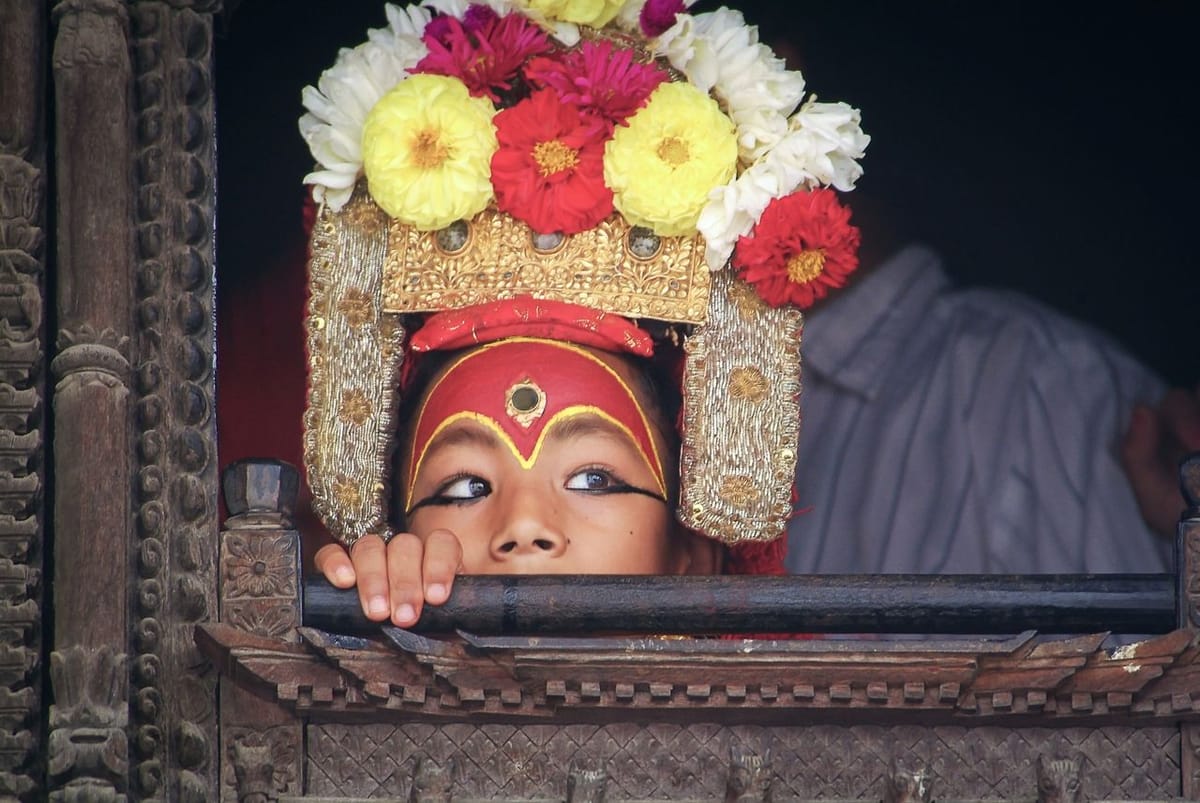

Culture and traditions form the backbone of any country’s history. Folklore, rituals, and oral traditions all narrate the untold history of a community. Such is the case with Nepal, a country known for its rich cultural heritage, which harbours one such tradition — “Kumari Worship” — that has made headlines for years.
The ‘Kumari’ or ‘The Living Goddess’ of Nepal is a selected prepubescent girl child, who is believed to be the manifestation of the divine female energy. Believed to be possessed by Goddess Taleju, the Kumari is worshipped like a Goddess by the people of the country.
Who are Kumaris?
Kumaris are prepubescent girls belonging to the Newar Shakya clan of a Buddhist Community. This tradition, prevalent in the Kathmandu Valley, requires a girl child to possess all the qualities that a ‘Kumari’ or a ‘Goddess’ should have. These requirements include the child being 2-4 years old at the time of the appointment, and she must complete her tenure as soon as she starts her first menstrual cycle.
Selection Process
A rigorous process selects a Kumari. Once the existing Kumari has completed her tenure, the Royal Priests invite all the members of the Shakya clan to nominate a potential candidate. The candidate must be in excellent health, must never have shed blood or been afflicted by any diseases, must be without blemish, and must not have yet lost any teeth. Girls who pass these basic eligibility requirements are examined for the battis lakshanas, or "thirty-two perfections" of a goddess, which involves their bodies being stripped of all clothing for inspection.
Along with the physical requirements, the candidate is also required to pass certain tests. Some accounts mention that the candidates are required to spend a night in a dark room with mutilated animal heads and bodies. If the candidate does not show fear or distress, she is believed to be a ‘courageous’ manifestation of Taleju.
Once the candidate is finalised, the newly selected Kumari is taken to the Royal Kumari Palace. The Kumari spends the rest of her tenure in the said palace, making occasional public appearances.
The Daily Life of A Kumari
The daily life of a Kumari is completely different from that of other children of her age. The Kumari is not allowed to walk on the ground as her feet are considered sacred. When she ventures out, she is carried in her golden palanquin, and she is required to be lifted by her servants for her commute. The King, bureaucrats, and even international leaders visit the Kumari and touch her holy feet.
A Kumari resides on her Lion Throne during ceremonies and offering presentations. People make offerings to the Kumari, and she is expected to consume a part of it while having an impassive expression throughout these ceremonies. Any expression or emotion expressed by a Kumari is considered to have an underlying meaning.
“My Mom used to tell me that once I cried a lot for 4 days straight. She tried to console me with toys, asking me what was wrong. She thought that maybe because I was not allowed to go outside or that I had to follow a lot of rules, maybe that is why I was crying. But the priests and the devotees had already forecasted that something bad was going to happen. Something bad did happen; the Royal Family Massacre occurred." Chanira Bhajracharaya, Former Kumari of Patan, said in a BBC interview.
Current Kumaris of Nepal
The Kumari tradition is prominent in the Kathmandu Valley region of Nepal. With the Royal Kumari of Kathmandu having the highest rank, the other two important Kumaris belong to Patan and Bungamati.
Arayatara Shakya, the current Royal Kumari of Kathmandu, succeeded Trishna Shakya in September 2025, whose tenure concluded with her first menstrual cycle. On the other hand, Nihira Bajracharya and Yubika Bajracharya are serving as the Kumaris of Patan and Bungamati, respectively.

Controversial Opinions on Kumaris
Many human rights organisations and activists have condemned this tradition. According to them, this practice is child labour in the guise of religious beliefs and traditions. From the selection process to the rules and regulations that come with the title, everything has been criticised. Many believe that keeping the Kumari in a secluded Palace with no human contact other than her attendants can have an impact on her social skills. Which would make it harder for them to return to their normal life.
Keeping in mind the concerns of the people, the Government of Nepal made some amendments to the provisions regarding the Kumaris in 2007, allowing them to get personal tuitions for basic schooling and skills like dancing and singing. Although considered omniscient by the devotees, they still need human interaction and education.
However, many NGOs and Government organisations are working on finding ways to balance this tradition with the evolving world. Kumari Support groups started by formers Kumaris are also aiming to help the incoming and current Kumaris navigate the space and changes with ease.
